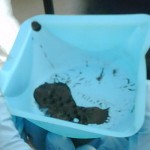Today was a very hands-on day as we spent most of the afternoon working on fairly simple yet interesting lab projects. The first project involved the creation of ferrofluid. Essentially, the ferrofluid was a highly magnetized viscous, black liquid that was easily manipulated through the use of a small magnet (as pictured in the image directly below). It was not especially difficult to form the ferrofluid as it only involved the mixing, diluting, and draining of a few various chemicals. The most interesting part of the end result, however, was the manner in which the ferrofluid would react to the magnetic block when said block was held about a 1/4 inch or so away from the weightboat containing the fluid. In most cases, the fluid would “spike” up, forming various pointed black ridges that would rise and fall depending on the manipulation of the magnet below.
It was not especially difficult to form the ferrofluid as it only involved the mixing, diluting, and draining of a few various chemicals. The most interesting part of the end result, however, was the manner in which the ferrofluid would react to the magnetic block when said block was held about a 1/4 inch or so away from the weightboat containing the fluid. In most cases, the fluid would “spike” up, forming various pointed black ridges that would rise and fall depending on the manipulation of the magnet below.

In reaction to the magnet, the ferrous fluid would rise up in small spiked formationsIt was interesting to play with the various ways the ferrofluid could be manipulated. Depending on how the magnet was moved, you could create many different shapes by pulling and stretching the fluid around with the use of magnetic forces. The resulting formations were distinctly artistic, making the end result of the experiment highly subject to creative impulses while the initial procedure itself remained a bit more structured and scientific. The second lab involved the creation of a lithograph. This project was a bit more art-based but was executed in a more science intensive manner than most other art creations. Ultimately, the experiment resulted in a small chip that contained a previously drawn design. The resulting litograph
In contrast to the ferrous fluid experiment which started out with science (the procedure) and ended in art (the spikey black fluid), the lithograph began with art (the initial design) and finished with science (the process used to transplant the design to the chip). Both, however, served as excellent examples as to how science and art could be applied together to achieve a single goal.